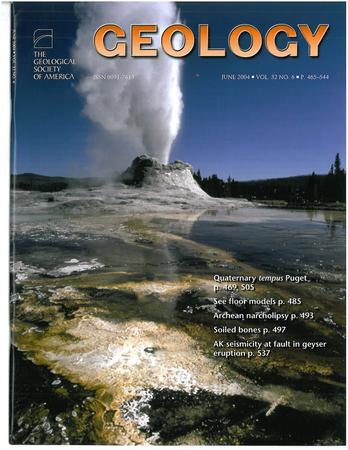Small dip, big impact: How 1° strata inclination affects density-driven flow in anisotropic rocks
IF 4.6
1区 地球科学
Q1 GEOLOGY
引用次数: 0
Abstract
Density-driven flow caused by fluid density contrasts in saturated porous rocks plays a critical role in many geological applications, including mineral exploration, hydrogen or carbon storage, and the migration of brines or hydrocarbons. Yet, the influence of anisotropic permeability on density-driven flow, as is common in sedimentary basins, is generally overlooked. By expressing the gravitational force acting on fluids with contrasting densities in anisotropic saturated porous media, we analytically estimate the velocity and angle of a propagating plume as functions of the dip angle of the permeability tensor and the ratio of longitudinal to transverse permeability anisotropy (r). The sensitivity of the plume angle to the bedding angle is greatest in the common case of near-horizontal layers. We demonstrate how, for large permeability anisotropy (e.g., r >100), a dip of only 1° dramatically affects plume migration compared to the perfectly horizontal case. This highlights the need for accurate representation of strata orientation and associated anisotropy in fluid-flow simulations. These results could affect mineral exploration strategies in sedimentary basins, where the slope and anisotropy of sedimentary strata could result in dense mineralizing brines migrating closer or farther from their source than previously expected. Overall, these findings are pertinent to the propagation of both lighter and denser plumes, e.g., supercritical CO2 or brines, revealing where and how fast these plumes can migrate through the dipping, anisotropic strata in sedimentary basins.小倾角,大影响:1°地层倾角如何影响各向异性岩石中的密度驱动流动
饱和多孔岩石中由流体密度差异引起的密度驱动流动在许多地质应用中起着至关重要的作用,包括矿产勘探、氢或碳储存以及卤水或碳氢化合物的运移。然而,各向异性渗透率对密度驱动流的影响在沉积盆地中很常见,但通常被忽视。通过表达各向异性饱和多孔介质中作用于不同密度流体的重力,我们分析估计了传播羽流的速度和角度作为渗透率张量倾角和纵向与横向渗透率各向异性之比(r)的函数。羽流角对层理角的敏感性在一般的近水平地层中最大。我们证明,对于大渗透率各向异性(例如,r >100),与完全水平的情况相比,仅1°的倾角如何显著影响羽流迁移。这突出了流体流动模拟中准确表示地层取向和相关各向异性的必要性。这些结果可能会影响沉积盆地的矿产勘探策略,在沉积盆地中,沉积地层的坡度和各向异性可能导致密集的矿化盐水比先前预期的离源更近或更远。总的来说,这些发现与较轻和较密羽流的传播有关,例如超临界CO2或盐水,揭示了这些羽流在沉积盆地中倾斜的各向异性地层中迁移的位置和速度。
本文章由计算机程序翻译,如有差异,请以英文原文为准。
求助全文
约1分钟内获得全文
求助全文
来源期刊

Geology
地学-地质学
CiteScore
10.00
自引率
3.40%
发文量
228
审稿时长
6.2 months
期刊介绍:
Published since 1973, Geology features rapid publication of about 23 refereed short (four-page) papers each month. Articles cover all earth-science disciplines and include new investigations and provocative topics. Professional geologists and university-level students in the earth sciences use this widely read journal to keep up with scientific research trends. The online forum section facilitates author-reader dialog. Includes color and occasional large-format illustrations on oversized loose inserts.
 求助内容:
求助内容: 应助结果提醒方式:
应助结果提醒方式:


